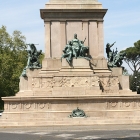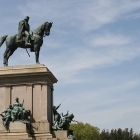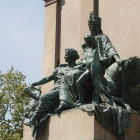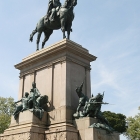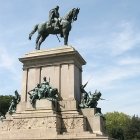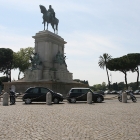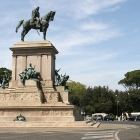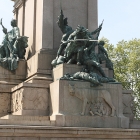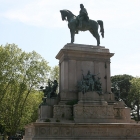Giuseppe Garibaldi, the hero of Italy
Garibaldi is the most celebrated Italian historic figure, with monuments, streets and public squares in almost every city of the country. Giuseppe Garibaldi is the artisan of Italy’s unification in today’s borders, or the Risorgimento, as the process was known. The reunification started in the aftermath of the defeat of Napoleon. The reactionary monarchs of Europe (mainly the Habsburgs, the British of the Tsar) favored a return to the pre-napoleonic state, with regions divided in their spheres of influence.
But the ideas of Enlightenment, of Liberalism and of Nationalism, that fueled the French Revolution of 1789 and the rise of Napoleon, continued to spread among intellectuals on the continent, often in the form of secret societies like the Freemasonry or the Carbonari in Italy. Movements of liberation calling people to overthrow the old monarchs appeared in many regions in the 19th century: in Spain, against the French domination, in Greece and Romania, against the Ottoman and Russian Empire, in Hungary against the Habsbourgs or in Italy against the Austrian domination. The Catholic Church was also opposed to these progressive and reformist movements.
The person who acted as the ideologist of Italian unification was Giuseppe Mazzini, who put on paper the plan of uniting the Peninsula while being in prison for political acts. During that time Rome and its surroundings were controlled by the Vatican, Lombardy and Venice by Austria, Naples and Sicily by Bourbon kings, while Piedmont and Sardinia acted as independent kingdoms. Mazzini dreamed of a unified republic, but had to settle for a unified kingdom under Victor Emmanuel II. Another important figure of Risorgimento was Count Cavour, the pragmatic prime-minister who had some differences of opinion with the revolutionary Garribaldi.
Garibaldi was born in Nice, which he dreamed of regaining from the French. For his revolutionary ideas, he was sentenced in absence to death, but managed to flee to South America. It was here where Garibaldi met his wife, Anita, also a revolutionary who died during one of his marches, and where Garibaldi adopted his characteristic red shirt and poncho from. The life story of Garibaldi resembles the one of Simon Bolivar or Che Guevara, moving from one country to another and calling to revolt. He inspired or took place in riots in Brazil and Uruguay, where he spent more than a decade, and as a genuine adventurer traveled allover the world, including China. His second exile was in North America, in New York City.
He was member of the subversive movement Young Italy (Giovine Italia), created by Mazzini and used the European liberal revolution of 1848 as a useful moment to put his plans into actions. He gathered thousands of volunteers in several campaigns in the service of King Victor Emmanuel II of Sardinia against the Austrians and against the French who were defending the Papal power. He than proclaimed himself dictator of Sicily and marched back north to Rome. The process of unification took several decades of military campaigns and advertising the nationalist ideas. While these ideas failed to gather enough support in the beginning, the regular people being faithful to their monarchs or to the calls of the clerics, during Garibaldi’s marches popular support was overwhelming.
Today, some separatists from the south and north accuse the conspirators taking part in the Italian reunification, including Garibaldi, of taking part in a plot that was disadvantageous to either the developed and civilized North or to the wealthy kingdom of Naples in the South, but the process was a natural development for Italian nation.
This equestrian statue of Garibaldi is found in Gianicolo, on a hill overlooking the St Peter’s cathedral in the Vatican, or the Tiber on the other side. This monument stands on the spot of an important battle fought by Garibaldi’s volunteers against the French defending the Pope. Made by Emilio Gallori, it was inaugurated in 1895. The statue of Anita Garibaldi is a more recent work by Mario Rutelli. In the fascist era the monuments from Gianicolo celebrating the Italian heroes were reconstructed by Giovanni Jacobucci.
Mai multe despre: Italia • Emilio Gallori • equestrian statue • Gianicolo • Giuseppe Garibaldi • Italia • Italy • Mario Rutelli • Risorgimento • Roma • Rome • statue- Home Page
start page - Architecture
landmark buildings - Sacred architecture
places of worship - Nature
landscape photography - Concert
performing artists - Christmas
Santa Claus pictures
- Jooble
jobs for photographers - Escape
an out of control blog - Merry Christmas
The best organizer of Christmas parties - Astro photo
Eclipse hunting and astrological photography

